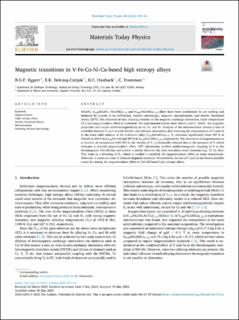| dc.contributor.author | Fischer Eggert, Bruno Guilherme | |
| dc.contributor.author | Delczeg-Czirjak, Erna K. | |
| dc.contributor.author | Hauback, Bjørn Christian | |
| dc.contributor.author | Frommen, Christoph | |
| dc.date.accessioned | 2023-09-26T11:13:45Z | |
| dc.date.available | 2023-09-26T11:13:45Z | |
| dc.date.created | 2023-06-14T17:07:08Z | |
| dc.date.issued | 2023 | |
| dc.identifier.citation | Materials Today Physics. 2023, 35 . | en_US |
| dc.identifier.issn | 2542-5293 | |
| dc.identifier.uri | https://hdl.handle.net/11250/3092034 | |
| dc.description.abstract | FeCoNi, V0.85FeCoNi, FeCoNiCu1.15 and V0.85FeCoNiCu1.15 alloys have been synthesized by arc melting and analyzed by powder X-ray diffraction, electron microscopy, magnetic measurements, and density functional theory (DFT). The influence of each alloying element on the magnetic exchange interaction, Curie temperature (TC) and magnetocaloric effect is evaluated. The experimental results show that Cu and V “dilute” the magnetic properties and couple antiferromagnetically to Fe, Co, and Ni. Analysis of the microstructure reveals a lack of solubility between V and Cu with FeCoNi, and between themselves, thus lowering the concentration of V and Cu in the main solid solution of the 5-element alloy V0.85FeCoNiCu1.15. Tc decreases significantly from 997 K in FeCoNi to 245 K in V0.85FeCoNi and 297 K in V0.85FeCoNiCu1.15, respectively. The derivative of magnetization as a function of temperature (dM/dT) in the vicinity of Tc is drastically reduced due to the presence of V which indicates a reduced magnetocaloric effect. DFT calculations confirm antiferromagnetic coupling of V to the ferromagnetic FeCoNi-base and predict a similar behavior for other transition metal elements (e.g., Ti, Cr, Mn). This leads to a lowering of Tc, which is needed to establish the magnetocaloric effect at room temperature. However, it comes at a cost of reduced magnetic moments. Nevertheless, the use of V and Cu has shown possible routes for tuning the magnetocaloric effect in FeCoNi-based high entropy alloys. | en_US |
| dc.description.abstract | Magnetic transitions in V-Fe-Co-Ni-Cu-based high entropy alloys | en_US |
| dc.language.iso | eng | en_US |
| dc.rights | Navngivelse 4.0 Internasjonal | * |
| dc.rights.uri | http://creativecommons.org/licenses/by/4.0/deed.no | * |
| dc.title | Magnetic transitions in V-Fe-Co-Ni-Cu-based high entropy alloys | en_US |
| dc.title.alternative | Magnetic transitions in V-Fe-Co-Ni-Cu-based high entropy alloys | en_US |
| dc.type | Peer reviewed | en_US |
| dc.type | Journal article | en_US |
| dc.description.version | publishedVersion | en_US |
| dc.rights.holder | © 2023 The Authors. Published by Elsevier Ltd. | en_US |
| dc.source.pagenumber | 10 | en_US |
| dc.source.volume | 35 | en_US |
| dc.source.journal | Materials Today Physics | en_US |
| dc.identifier.doi | 10.1016/j.mtphys.2023.101116 | |
| dc.identifier.cristin | 2154607 | |
| dc.relation.project | Norges forskningsråd: 287150 | en_US |
| cristin.ispublished | true | |
| cristin.fulltext | original | |
| cristin.qualitycode | 1 | |

